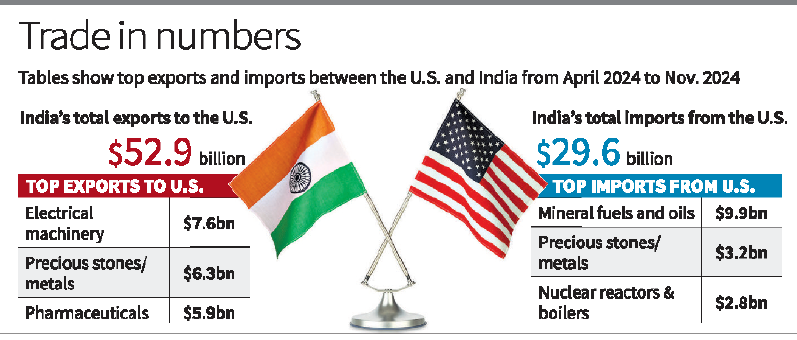U.S. Reciprocal Tariffs

- 09 Mar 2025
In News:
On April 2, 2025, the United States is set to implement reciprocal tariffs as announced by President Donald Trump during his address to a joint session of the U.S. Congress. The move targets major trade partners including India, China, the European Union, Canada, and Mexico.
What Are Reciprocal Tariffs?
- Definition: A reciprocal tariff is a trade measure in which a country imposes import duties equal to the tariffs its exports face in other nations.
- Objective: To establish a level playing field, correct trade imbalances, and respond to unfair tariff structures by trading partners.
- Application:
- If a foreign nation imposes high tariffs on U.S. goods, the U.S. will match that rate on goods imported from that country.
- Applies to goods, services, and even non-tariff barriers limiting U.S. market access.
Why Now? Trump’s Trade Strategy
- President Trump cited India’s high tariffs on automobile imports (reportedly over 100%) as an example of unfair trade.
- The U.S. also flagged China, EU, Brazil, and Mexico for imposing higher duties on U.S. exports.
- Trump emphasized that the U.S. has been “taken advantage of for too long” and that reciprocal tariffs are necessary to protect American jobs and industry.
WTO Implications
- May violate WTO's Most-Favoured-Nation (MFN) rule, which mandates equal treatment of trade partners.
- The U.S. could invoke Article XX (general exceptions) or Article XXI (national security exception) of the WTO Agreement to justify its policy.
Potential Impacts of Reciprocal Tariffs
Positive Impacts Negative Impacts
Boosts U.S. manufacturing by reducing import dependency May trigger retaliatory tariffs,
escalating trade wars
Encourages tariff reductions by partner nations Leads to higher import prices and
consumer inflation
Aims to reduce the trade deficit Causes economic uncertainty
and hurts investor confidence
Promotes domestic job creation May lead to WTO disputes and
strain diplomatic relations
